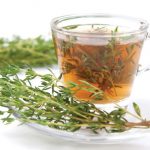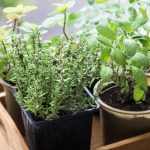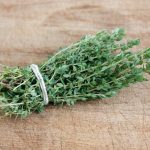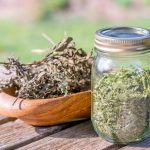Tantalizing Ways To Use Thyme
Thyme has many uses, from kitchen to natural health to home care. It is the most versatile herbs around. In the kitchen it adds savory flavor to roasted meat, soups, vegetables or fish. It also imparts exciting flavor to marinades, stocks and soups, cocktails and teas. Thanks to the potent natural antiseptic thymol, found in the plant’s leaves which are extremely useful.
What does it taste like?
Fresh thyme has a pronounced, concentrated herbal flavor with sharp grass, wood and floral notes. The fragrance of the lemon variety is more prominent.
Here is a list of its uses:
1. Cough syrup– according to the German Commission E, thyme is an approved treatment for coughs, bronchitis, respiratory infections. Try this simple recipe of cough syrup to get relieved;
– Boil 1 cup water
– Remove from heat
– Add thyme and let it sit for 20 minutes
– Strain and whisk with ½ cup honey.
This syrup can be refrigerated in a glass jar for up to 1 month.
2. Cold- busting herbal tea– mucus buildup in the throat and lungs can linger if not attended to on time. Thyme is a strong antimicrobial, antispasmodic and relaxant for the bronchi. Thyme tea makes a great gargle for gum disease and sore throat. Mullein soothes itchy and irritating coughs. Horehound has gentle, expectorant, stimulating effect on the lungs which helps in clearing away the phlegm. Here’s how to combine these 3 effective herbs:
– 2 teaspoons dried mullein flowers/leaves
– 2 teaspoons dries horehound flowers/leaves
– 2 teaspoons dried thyme
– 2 cups boiling water
• Add these 3 herbs in a teapot
• Add the boiling water, cover and let it steep for 10 minutes. Strain and drink hot
Drink 2-3 cups a day of this tea for a week or until the symptoms disappear.

CAUTION: avoid thyme during pregnancy as it is a uterine stimulant.
3. Skin cleanser- try this 4 ingredient cleanser for a clear skin;
– ¼ cup pure honey
– ¼ cup water
– 1 teaspoon fresh chopped thyme
– 2 teaspoon liquid castile soap
Massage a small amount into skin, rinse with warm water and pat dry.
4. All purpose cleaner– add 10 drops of antiseptic thyme essential oil to 1 gallon of hot water and ½ cup castile soap. Pour into a spray bottle and clean anywhere in your home.
5. Insect repellent– a study found that thyme oil when applied to the skin, repelled mosquitoes for 1-3 hours in a lab setting. But some essential oils can cause dermatitis, so it should be mixed with a carrier oil, like coconut oil, before application.
Coming to a list of few cooking styles that are definitely irresistible;
• When baking bread, add a few pinches of dried thyme to the flour and your bread would taste great with butter.
• Add dried leaves to your favorite pasta sauce and voila! It tastes so yummy.
• You can also decorate your desserts, like custards.
• Leaves without the stem just work great when added to fresh veggie salad. It gives your salad a kick that no dressing will achieve on its own.
• Dried thyme added right at the end of cooking to soups brings an aroma to the dish that is hard to miss. Just add the herb and immediately remove from heat and keep covered. The soup will smell heavenly.

• Vegetables and seafood have a mild flavor and fresh thyme leaves work wonders in bringing out the subtle flavors and the taste is just electrifying.
• Fresh leaves can be used in the marinade which gives meat a savory taste.
Wit and Wisdom: Burning thyme inside the house can help get rid of unwanted insects.
What’s your favorite way to use this effective and wonderful herb? Let us know in the comment box!





